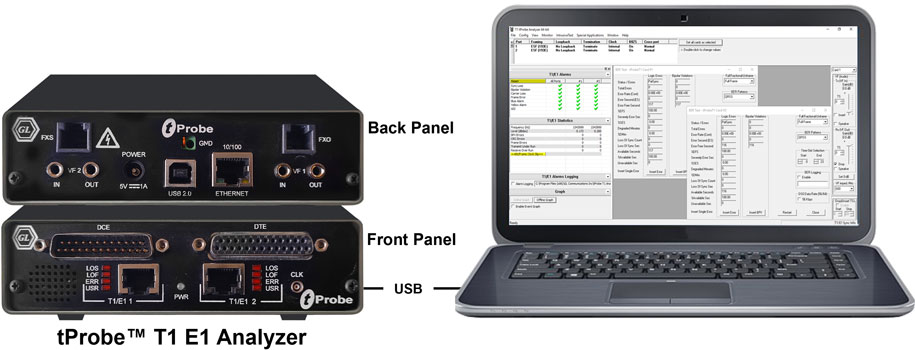T1 E1 Monitoring, Analysis and Emulation Capabilities
Welcome to the latest issue of GL's Newsletter, providing insight into our tProbe™ - T1 E1 VF Serial Data Analysis and Emulation hardware. Its compact design, portability, USB interface, and remote accessibility features make it suitable for field testing, monitoring, and troubleshooting network conditions.

Overview
T1 E1 carriers are still used extensively throughout the world for carrying large volumes of voice and data traffic. Their popularity can be attributed to their high reliability, manageability, and flexibility. The available digitized channels (24 for T1 and 32 for E1) can be used separately or they can be combined to provide higher transmission bandwidth.
GL's tProbe™ is a test and measurement device for T1 E1 networks. It is portable, remotely accessible and allows for a vast collection of applications. The tProbe™ can monitor and emulate common voice protocols including ISDN, SS7, CAS, etc. The tProbe™ also includes optional boards such as Datacom (DCE or DTE) and FXO FXS ports. The FXO port on the tProbe™ can simulate a two-wire FXO device such as a telephone or a fax machine.
The tProbe™ Datacom Analyzer is designed for the installation, verification, and maintenance of data communication and telecom equipment. It offers a software-selectable interface for emulating DTE and DCE, as well as monitoring data communication lines for both synchronous (sync) and asynchronous (async) modes of operation.
GL's Windows Client/Server (WCS) software allows T1 E1 analysis and emulation cards with remote operation, automation, and multi-site connectivity capabilities. The supported client is Python, and it can run on various operating systems, including Unix, Linux, and Windows®.
Additionally, the, Windows/Linux Client (WLC) is a Command Line Interface application. It sends commands to T1 E1 WCS servers and shows the responses in Console, PowerShell, or Terminal Windows. WLC functions in both Windows and Linux. Furthermore, it can be utilized on any operating system through SSH or another remote access terminal. WLC is a portable library for communication between Windows®/Linux clients and WCS servers, ensuring compatibility.
tProbe™ - Form Factors
The tProbe™ is controlled by a Windows® PC via a USB connection. Customers often request a complete solution in which the PC is included. GL offers the 1U Rackmount enclosure or a Probe unit, each with an embedded PC. For more details, refer to Multi-Interface TDM, Optical Rackmount & Probe Test Platforms webpage.
Main Features
- Monitor T1 E1 line conditions such as frame errors, violations, alarms, frequency, power level and clock (or frame/bit) slips. Monitor all timeslots in real-time
- Comprehensive Analysis / Emulation of Voice, Data, Fax, Protocol, Analog, and Digital signals, including Echo and Voice Quality testing
- T1 E1 Pulse Shape, Jitter Measurement Analysis, and Jitter Generation
- Software selectable T1 or E1 interface along with Drop and Insert
- tProbe™ FXO and FXS board allows simulating FXO and FXS ports. The FXO port is used to simulate a two-wire FXO device such as a telephone or a fax machine. The FXS port is used to simulate a 2-wire FXS service such as a telephone wall jack
- Datacom board supports V.24, V.35, V.36, RS-449, RS-485, EIA-530, and EIA-530A interfaces and can be configured as DTE or DCE to test Channel Service Unit (CSU) and Data Service Unit (DSU) entities
- Physical layer analysis includes the ability to send alarms and errors via SNMP Traps
- Lightweight (1.24 lbs) and small footprint (6.05" x 5.55" x 1.60")
- Enhanced VF Drop and VF Insert Capabilities using 3.5mm Balanced (Stereo), or Unbalanced (Mono) physical connections
- mTOP™ T1 E1 Datacom FXO FXS 1U rackmount enclosure is a sleek appliance housing GL’s USB based tProbe™ with T1 E1 interfaces, FXO FXS card and Datacom card hardware units for unified testing experience of TDM and Analog technologies
- Python scripting support on both Windows® and Linux operating systems
- Routing and Bridging emulation over Multi T1 E1 WAN interfaces using MLPPP (Multi Link PPP) and Multi Link Frame relay (MFR) protocols
- Call Recording, generation, and monitoring for hundreds to thousands of calls in one platform
- Capable of simulating as well as decoding and demodulating fax calls over T1 E1 lines using Fax Simulator and FaxScan™
- Cross-port Through and Cross-port Transmit modes configurations make cabling with Drop/Insert and Fail-Safe Inline monitoring easy


 Back to Newsletter Index Page
Back to Newsletter Index Page